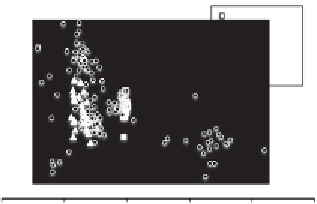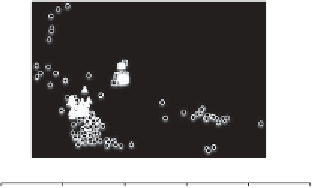Environmental Engineering Reference
In-Depth Information
57
4.5
SiO
2
wt%
TiO
2
wt%
4
4270/13
Cy50
Siberian Traps
OM24
55
3.5
53
3
2.5
51
2
1.5
49
1
47
0.5
0
45
0
5
10
15
20
25
0
5
10
15
20
25
Al
2
O
3
wt%
CaO wt%
25
14
12
20
10
15
8
6
10
4
5
2
0
0
0
5
10
15
20
25
0
5
10
15
20
25
MgO wt%
MgO wt%
Figure 10.2 Compositions of melt inclusions and Siberian Traps. 4270/13 and
Cy50 from Gudchikhinsky picrites after Sobolev
et al
.(
2009a
); Maslovskoe melt
inclusions in clinopyroxene from the Maslovskoe intrusion (OM24). Siberian
Traps after Fedorenko
et al
.(
1996
).
Ion microprobe analyses were conducted on the IMS-4f ion probe at the Institute of
Microelectronics, Yaroslavl, Russia (Sobolev,
1996
).
We compared our new data with published analyses of melt inclusions in olivine
from two samples of Gudchikhinsky picrite (Cy50 and 4270/13) which lie near the
base of the stratigraphic sequence (Sobolev
et al
.,
2009a
), the Maymechinsky suite
of the Maymecha
inclusions in plagioclase from the Onkuchaksky suite of the Maymecha
-
-
Kotuy
10.2.2 Major and trace elements of melt inclusions
The compositions of melt inclusions in clinopyroxene of the Maslovskoe intrusion
match well the compositions of typical low-Ti tholeiites for most major and trace
elements (
Figures 10.2
,
10.3
). Like most Siberian
flood basalts, they possess a
clear trace-element signature of contamination by continental crust (positive Pb,
U and Rb anomalies and negative Nb anomalies) and no evidence of garnet in the
source (
(flat heavy rare earth elements (HREE)). In contrast, melt inclusions from











